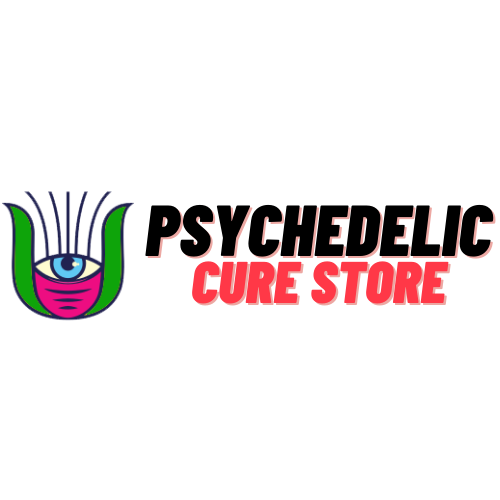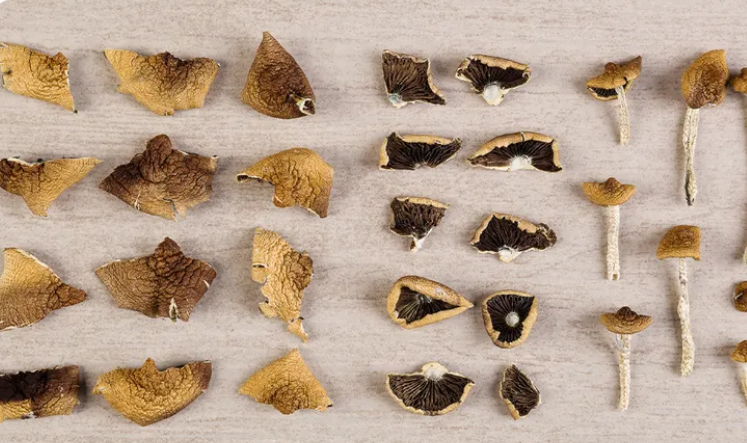Blog
What is magic mushroom?
The magic of magic mushroom comes from the psilocybin that lies within them. “Psilocybin is a molecule… produced by over 100 mushroom species, likely to fend off various insects and/or microorganisms,” explained Marshall Tyler, Director of Research at Field Trip Health. “When these mushrooms are consumed by humans, the liver converts psilocybin into the psychoactive molecule psilocin.”
There are different varieties of psychedelic mushrooms scattered across the globe. Psilocybe cubensis, also affectionately referred to as the “Golden Teacher,” is the most common. Other popular magic mushrooms include “Liberty caps” (Psilocybe semilanceata), “Wavy caps” (Psilocybe cyanescens), and “Flying Saucers” (Psilocybe azurescens). Most psilocybin mushrooms tend to have light-brown to gold-colored caps with slender stems.
Shroom hunters can pick out magic mushrooms by their trademark feature of blue bruising: Stems turn a blue shade when picked, a giveaway that psychoactive molecules lie within.
Besides growing in the wild, psilocybin can also be formulated synthetically. The compound was first isolated from Central American mushrooms (Psilocybe mexicana) by renowned Swiss chemist Albert Hofmann in 1957, who earlier synthesized LSD.
Differences Among Magic Mushroom Strains
There are over 200 species of Psilocybe mushrooms, each possessing visually unique characteristics along with varying levels and ratios of three psychotropic compounds — psilocybin, psilocin, and baeocystin. A few of the most prevalent species are P. azurescens, P. cyanescens, P. semilanceata, and P. cubensis (which is the most widely known and easily cultivated).
There are also hundreds of “strains” or “subspecies” which have been genetically isolated and classified by both professional mycologists and recreational enthusiasts. While taxonomically these strains are all considered members of their respective species (and most are P. cubensis), they too can differ drastically in appearance, conditions required for cultivation, and potency.
Common species
*Psilocybe cyanescens *Psilocybe cubensis *Psilocybe semilanceata
Common Strains
*Huaulta cubensis *Penis Envy cubensis *Golden Teacher cubensis
This introduction to mushroom strains and species may seem contradictory or confusing. That said, a useful analogy for understanding the differences can be drawn between Cannabis and Psilocybe mushrooms. The separation of cannabis species into indica, sativa, and ruderalis corresponds to the separation of Psilocybe species into azurescens, semilanceata, cubensis, etc. Meanwhile, the separation of cannabis strains like Northern Lights, Purple Kush, and Jack Haze corresponds to mushroom strains like Penis Envy, Golden Teacher, and Huaulta.
Unlike cannabis, where the crossing of genetics combines plant traits to create a new weed strain, mushroom strains often start with a desirable mutation, such as being albino or growing especially large mushrooms. These random mutations can be selected and cloned for several generations from the largest, healthiest mushrooms of each life cycle, to create a new strain in a process known as “isolation.”
The effects, duration, and onset of the psychoactive experience provided by different species and strains (along with many other variables) can differ quite drastically among shrooms. However, all members of the genus Psilocybe share a few keys identifying factors that can aid in their identification.
They all bruise an azure-bluish color when handled or damaged, due to oxidation of the compound psilocin at the site of impact
They all have a thin gelatinous veil, known in mycological terms as a “pellicle,” that separates the cap (or pileus) from the stem (or stipe). In maturity, this veil often disintegrates, leaving a darkened section (annular zone) on the stem
They all have dense gills on the underside of the cap (or pileus) and a shiny or silky film on the outside of the cap
They all have a hygrophanous nature (meaning coloration changes with the state of hydration)
Psilocybin-Containing Shroom Species
The differing Psilocybe species have a much longer and more intensive taxonomical history than the relatively recent distinctions among strains. The first reliable documented case of Psilocybe intoxication occurred in 1799, when a man picked several semilanceata from the shores of the Thames River in London, and cooked a meal for his family with them. This surprise trip spurred the classification of a new species of mushroom, which was placed in the genus Agaricus, then moved to Psilocybe in 1871. For the purpose of remaining succinct, this article focuses on the four species most commonly found in North America.
- semilanceata
- semilanceatas, often referred to as “Liberty Caps,” are one of the most widespread, potent, and commonly-recognized members of the Psilocybe genus. They are easily distinguishable by their conical-bell-shaped cap which holds its shape throughout the life cycle, dissimilar to most other Psilocybe shrooms whose caps flatten in maturity. They are also, on average, smaller than other species, often with a thin, elongated, somewhat fragile-looking stem, and a spear-shaped cap from which the name “semilanceata” (meaning “spear-shaped” in Latin) comes.
Testing done by mycologists Paul Stamets and Jochen Gartz placed Liberty Caps as the third most potent Psilocybe species, with an exceptionally high concentration of psilocybin, low concentration of psilocin, and moderate levels of biocytin. The high concentration of psilocybin often leads to semilanceata mushrooms eliciting a very visual experience that also lasts longer than those of other species, due to the body having to break down this psilocybin into psilocin before the effects are felt.
- cyanescens
- cyanenscens are another prolific species of mushroom that can be found worldwide but are thought to have originated in North America. They are distinctly more mycorrhizal than other species, meaning they require decaying wood in order to grow. This makes them more difficult to cultivate indoors, though that has not hindered their spread into every habitable continent.
Unlike many other organisms whose habitats have been encroached on by humans, these mushrooms are thought to share a symbiotic relationship with urbanization. They are commonly found on piles of ligneous debris or in mulched garden beds, and sometimes in enormous quantities exceeding 100,000 mushrooms in a single patch.
They can be identified by the undulating edges of their caps, and aside from this wavy cap, possess visual characteristics quite similar to P. cubensis — thick stems and caps that begin rounded or bell-shaped and flatten (sometimes even becoming convex) in maturity. Despite their visual similarity to P. cubensis, they are significantly more potent than their more common brethren, on average containing 30 to 60 percent more psilocybin, similar concentrations of baeocystin, and slightly less psilocin. The experience occasioned by taking P. cyanescens is mostly analogous to that of P. cubensis, though with notably intensified visuals (a result of higher psilocybin concentration).
- azurescens
- azurescens are the rarest, most potent, and most recently discovered Psilocybe species. Similar to many other mushrooms, they were discovered by recreational mycology enthusiasts (a group of Boy Scouts, ironically enough). This potential to find an entirely new species is undoubtedly one of the attractive properties of mycology (the study of mushrooms) and exists whenever one embarks on a mushroom-hunting adventure.
To date, over 120,000 species of fungi have been discovered, and this number is constantly growing. Unlike other Psilocybe species, P. azurescens are only found in the Pacific Northwest region of North America and carry the highest concentration of psilocybin out of all members of the genus. Due to extremely high psilocybin levels, they produce vivid hallucinations, intense amplification of emotions, and sometimes even temporary paralysis.
- cubensis
Generally when someone speaks about “magic mushrooms” or “shrooms,” they are referring to P. cubensis. The natural geographic range of this species is limited to tropical and subtropical regions, but they can be (relatively) easily cultivated indoors, making them the most popular and most easily accessible “magic mushrooms.” Many websites even offer mushroom grow kits, which are legal in many countries, as mushroom spores do not contain psilocybin. Other websites go even beyond the law to offer dried mushrooms and microdose capsules.
- cubensis mushrooms often have thick, dense stems and large, broad caps. They also grow larger than most other species, although this is likely due to generations of genetic isolation. This species provides the classic psychoactive mushroom effects of euphoria, feelings of love and unity, introspection, philosophical ideation, synesthesia, visual augmentation, and a less ego-influenced perspective.
Shroom Strains
Due to the comparative ease of cultivation (at least, those not requiring decomposing wood or dung to grow), the vast majority of recognized strains all fall under the umbrella of the P. cubensis species. Although the exact number is difficult to determine, and new strains are consistently being created, mycologists estimate that there are around 150 distinctly identifiable P. cubensis strains. This article cannot possibly cover them all, so we will focus on three of the most prominent strains. If you are interested in delving further into the differences among strains, check out Psilopedia.ca which offers the widest catalog of P. cubensis strains online.
Golden Teacher
This strain was first classified in the late ‘80s, and since then, the name Golden Teacher has become almost ubiquitous with psilocybin mushrooms. Golden Teacher mushrooms are medium to large in size and often feature a distinct triangular bump in the center of their golden caramel-colored caps. It is a moderately potent strain ideal for beginning shroom psychonauts, one that offers a subtly more spiritual, introspective undertone to the experience, along with feelings of euphoria and uncontrollable laughter. This makes Great Teacher well suited for both social recreational use and therapeutic or medicinal applications.
Penis Envy
Penis Envy P. cubensis has an interesting history. It is theorized the strain was isolated from Amazonian P. cubensis (another popular strain) by legendary ethnobotanist and psychonaut Terence McKenna. Since Mckenna’s original isolation, many variations of Penis Envy have subsequently been created, such as Albino Penis Envy and Uncut Penis Envy. All of these variations have characteristics that are clearly distinct from other P. cubensis strains, consisting of substantially higher potency (30 to 50 percent); extremely thick, dense stems; and pale, underdeveloped caps — making them somewhat resemblant of the organ for which they were named. They are known to generate an experience filled with deep philosophical ideations and intense feelings of euphoria.
Huautla
This strain was one of the first to be classified and is thought to be the mushroom referred to by R. Gordon Wasson in the famous LIFE Magazine article “Seeking the Magic Mushroom” which popularized psilocybin mushrooms throughout Western cultures. Its name comes from the village of Huautla De Jiménez in Oaxaca, Mexico where Wasson’s experience took place. Huautla is typically medium-sized mushrooms of moderate potency that separate very heavily, often turning the caps purple-black with spores. They are known to reliably elicit spiritually meaningful experiences permeated with intense feelings of love and unity, along with a sense of connection with nature and the universe as a whole.
https://merryjane.com/culture/what-are-the-differences-among-magic-mushroom-strains-and-their-trips

